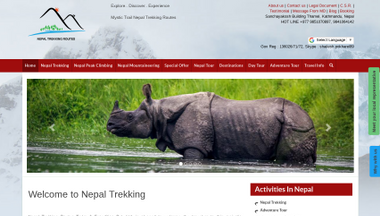Here goes yet another piece of the huge Everest and Himalaya chronicle compiled by ExWeb contributor Rodrigo Granzotto. The Brazilian stats ace is now focusing on massive 8000er summiteers, lower peaks, new routes, amazing rescues and Sherpas racing for the ’14x’ mark.
Everest & Himalaya 2010 Season’s End Chronicle: part 4
by Rodrigo Granzotto Peron
20K POTENTIAL–FAST RUNNING FOR 30K
The first climber to reach 8000er summits 20 times was Juanito Oiarzabal (SPA). He now has 23 (or possibly 24), the actual world record (1*). So far, Juanito has repeated EV, K2, KG, MK, CH, G1 and G2 (Annapurna 2010 is contested). He is the first person to repeat the Top Three (two summits on EV, on K2 and on KG).
The second climber to summit 20x8000ers was Ed Viesturs (USA), on Annapurna in 2005. After some years of absence, he came back last year as part of the expedition organized by First Ascent. With seven summits on Everest, Ed now has 21 main 8000ers.
Several Sherpas have also broken the 20k barrier recently. The list includes Danuru (IMG guide), with 22 main 8000ers; Phurba Tashi (Himex guide), who summited Everest twice in 2010, also with 22; Apa, who ascended Everest for the 20th time, and is the first person to break the 20k barrier on just one 8000er; Tshering Dorje II Sherpa (Rolwaling Excursion), on his second summit of Makalu, now has 20. Mingma Tshering (Jagged Globe), who has 20 as well. In addition, both Chuwang Nima and Lhakpa Rita I, guides for Alpine Ascents, summited 20 times. So, now several outfits can be proud to have 20k Sherpa guides.
Situation of those who have conquered most of the main 8000ers:
23 Juanito Oiarzabal (SPA) (24 if including Annapurna)
22 Danuru Sherpa (NEP) [IMG]
22 Phurba Tashi Sherpa (NEP) [Himex]
21 Ed Viesturs (USA)
20 Apa Sherpa (NEP)
20 Chuwang Nima Sherpa (NEP) [Alpine Ascents]
20 Lhakpa Rita I Sherpa (NEP) [Alpine Ascents]
20 Mingma Tshering I Sherpa (NEP) [Jagged Globe]
20 Tshering Dorje II Sherpa (NEP) [Rolwaling Excursion]
19 Ang Rita Sherpa (NEP)
19 Chuldim Ang Dorje Sherpa (NEP) [Adventure Consultants]
19 Kami Rita I Sherpa (NEP) [Alpine Ascents]
18 Denis Urubko (KAZ)
18 Nima Gombu Sherpa (NEP)
18 Norbu (Nuru) Sherpa (NEP)
18 Park Young-Seok (S.K.)
18 Pasang Dawa (Pando) Sherpa (NEP)
18 Reinhold Messner (ITA)
17 Nima Dorje I Sherpa (NEP)
17 Ralf Dujmovits (GER)
17 Serap Jangbu Sherpa (NEP)
17 Sergio Martini (ITA)
17 Um Hong-Gil (S.K.)
17 Veikka Gustafsson (FIN)
An increasing number of climbers are between ten and 16 summits on 8000ers. In fact, more than 100 alpinists, including, for example, the recent 10k summiteers Simone Moro, Kim Chang-Ho, Palden Namgye Sherpa, Speed Pemba Sherpa, Vernon Tejas and Jorge Egocheaga Rodriguez.
And what is the absolute limit for the collectors? There is no limit at all. For example, if Juanito finishes his “double race”, he would end his journey with 14×2=28, plus two more summits on Cho Oyu–30 in total (30k). Sherpas could go even further. For example, a Sherpa beginning his career now at 20 years of age and working for an outfit at the rate of two-expeditions per year (EV in spring and CH in autumn) would enter the year of his 50th birthday with, more or less, sixty 8000ers summited (60k). With the current speed, we will start to see 30k climbers very soon–about three to four years from now.
NOTABLE ASCENTS ON LOWER PEAKS
I–Changtse (7,538m)
It is hard to be a lower satellite of such a colossal peak like Everest. Those peaks below the umbrella of Chomolungma are most of the time forgotten. It is the case of Changtse (7,538m), the highest sub-peak of the Everest massif in Tibet. Only 12 ascents registered, by 52 climbers, the last one in 1992.
This season, Alex Abramov (RUS), the leader of the respectful Seven Summits Club outfit, decided to end the hiatus, and summited Changtse with three Sherpas, on a partially new route (North Col South Ridge).
II–Takargo (6,771m)
It is a new year for a new virgin 6000er to the collection of these two great climbers who refuse to join the stream and, instead, look for challenging routes on lower peaks. The curriculum of David Gottlieb (USA) and Joe Puryer (USA) is coming to be plenty of luminous gems: 2008–Kang Nachugo (6,735m); 2009–Jobo Rinjang (6,778m); 2010–Takargo (6,771 m).
The first ascent of Takargo was performed in late winter (March 11-12). According to the sketches on the expedition website, the line goes up on the middle of the East Flank, then traverses the entire face to the extreme left, gaining the upper ridge that is entirely traversed back to the right up to the summit. The route literally makes an “S”.
By the way, the other expedition on Takargo, under leadership of Malgorzata Teresa Jurewicz (POL), was unsuccessful.
For the record: Talking about winter, there were some more activities in the coldest season of the year. Andy Parkin (UK) and Victor Saunders (UK) tried Lobuche West Peak (6,119m), but no cigar. Shinji Sato led an expedition to Khatung Kang (6484m), but gave up at 6,100 meters. And the major headline in winter was Renan Ozturk (USA) and Cory Richards (CAN) who ascended the Central Pillar of the S Face of Taboche (6,495m), a technically difficult route in pure winter weather.
III–Kojichuwa Chuli (6,439m)
Under leadership of Michihiro Honda, three Japanese climbers–Ken Fujikawa, Yuta Kawamura and Satoshi Kimoto–performed the first ascent of Kojichuwa Chuli, another beautiful 6000er first summited this season. The three previous expeditions (two from Spain in 2008 and 2009, and one from Japan in 2009) were unsuccessful.
IV–Ekdant (6,100m) and Kartik (5,115m)
Portuguese climbers Daniela Teixeira and Paulo Roxo are also “out of the stream”. They are always aiming for new routes, both virgin and seldom visited peaks. This season they paid a visit to Garwhal Himalaya and opened two alpine-style new routes. On Ekdant they performed the second ascent (the first complete new route on an Himalayan peak by climbers from Portugal); and on Kartik they opened a brand-new line: Directa Lusitana.
NEW ROUTES AND VARIANTS
I–Lhotse (W Face route and Kazakh upper variant)
The incredible Denis Urubko (KAZ) performed solo on this new route on the West Face of Lhotse. He went on the  high slopes of the fourth highest mountain and opened an upper variant that differs from the original Swiss Route of 1956. According to the sketches released to the press, the route is equal to the route of 1956 until 8,000 meters. Then, instead of traversing the upper S Col plateau to the couloir that leads to the summit, Denis went to the left, traversed the entire rock bands to the right, and then went to the summit by the ridge. This is the first new route on Lhotse in the past two decades and it is the first new route on the West Face since 1956.
high slopes of the fourth highest mountain and opened an upper variant that differs from the original Swiss Route of 1956. According to the sketches released to the press, the route is equal to the route of 1956 until 8,000 meters. Then, instead of traversing the upper S Col plateau to the couloir that leads to the summit, Denis went to the left, traversed the entire rock bands to the right, and then went to the summit by the ridge. This is the first new route on Lhotse in the past two decades and it is the first new route on the West Face since 1956.
Denis so far opened new lines on Broad Peak (SW Face, 2005), Manaslu (NE Face, 2006), Cho Oyu (SE Face, 2009) and Lhotse (W Face upper variant, 2010). An astonishing curriculum!
For the record: Lhotse is still the 8000er with less different routes. The regular W Face has only two: Swiss 1956 and Kazakh 2010. The dangerous and difficult S Flank has also two lines: Russian 1990 and Slovenian 1990, while the challenging E Face is completely virgin. Except for the standard route, none of the other routes were completely repeated. So, only four routes in 54 years. In comparison K2 has 11 routes and variants and Everest has 21.
II–Makalu (SW Face–Ukrainian Route)
The south side of Makalu, divided into two portions (SW Face and SE Face), has had several successful routes over the years: SE Ridge Complete (Japanese Route, 1970); Slovenian Route (1975); S Pillar (Czech/Slovak Route, 1976); SE Ridge and E Face (S Korean Route, 1982); and Beghin Route (1989). However, in the last two decades this flank has been neglected. In fact, the last new line on Makalu was a variant to the French Route, performed by Iñaki, Vallejo, Txikon, Martinez, and Ogwyn in 2004.
In 2010 several different expeditions explored this mighty face of Makalu.
A British expedition, under leadership of Colin Scott, tried again the SE Ridge Complete. Previously, Colin had led two expeditions on this route, one in 2004 and the other in 2008, without success. The American expedition of Chris Warner and Marty Schmidt aimed a new line on the southern slopes of Makalu. Warner, with HAPE symptoms, had to be airlifted out of the mountain. Schmidt tried alone, but gave up before summiting.
The Ukrainian team to the SW Face was led by Valentin Simonenko and Yuri Klugov, and comprised of several climbers who conquered Himalchuli in 2007. After installing five altitude camps, the first rope–Serguey Pugachov and Sasha Zakolodny–could not proceed to the summit. Two days later, the second rope–Dmitry Venslavovsky, Serguey Bublik and Vladimir Roshko–made it to the highest point. As reported, the crux was a barrier of rocks from 8,300 to 8,400 meters.
The new line follows the Slovenian Route of 1975 on the lower parts, then at the point it intersects the Beghin Route of 1989 inflects to the left until touching the W Pillar on c7,600 meters, following it to the main summit. The summiteers down climbed via the regular route, completing the third traverse on Makalu (Himalayan Database registers two previous traverses: Marc Batard, 1988, and Pierre Beghin, 1989).
For the record: The Ukrainians, mainly Serguey Bershov and Vladislav Terzyul, have participated in the opening of several very hard routes on 8,000ers, such as: Everest, SW Face (1982); Kangchenjunga, NE Ridge [traverse] (1989); Lhotse, S Face (1990); Annapurna, NW Face (1996); and Manaslu, SE Face – SE Spur (2001). Now, with Makalu, SW Face (2010), it is time for a new generation to keep the flame burning.
MIRACULOUS HELICOPTER RESCUES
Pakistani Army’s helicopter pilots are famous for the audacious and difficult rescues in high altitudes. The most known episode was the dramatic rescue of Tomaz Humar (SLO), trapped at almost 7,000 meters at the Rupal Face of Nanga Parbat in 2005.
Helicopter activity is very dangerous in thin air. So these pilots who risk their own lives to take stranded climbers out of the mountain are truly heroes. Nevertheless, the higher the riskier. The highest rescue operation by a chopper took place on Kamet in 2004 at 7,083 meters by an Indian Air Force’s SA315 LAMA.
In spring of 2010, Air Zemmatt (SWZ) and Fishtail Air (NEP) joined forces to provide the first standby helicopter rescue service in Himalaya, doing in Nepal the same incredible job that Pakistan’s pilots had performed over the past decade on Karakoram. As soon as the ‘season’ started to heat up, the service proved to be extremely necessary. On April 23 the body of a dead climber–Philip Ulrich (DEN)–was airlifted out of Kyajo Ri (6,186 m). Then came well succeeded operations on Manaslu (S Korean climbers), on Makalu (Chris Warner), on Dhaulagiri (Chinese climbers), among several others.
Since climbing 8000ers became touristic, it is clearly important to create a strong security and support structure to help those tourists who have had problems on the mountains. The joint operation between Air Zemmatt and Fishtail Air is one of the most important steps in this field. And the Spring of 2010 was really a landmark of air rescue.
SHERPA’S RACE IS GETTING HOT
There is another “race” going on, but of course without the media coverage that the womens race had. Several Sherpas are engaged in being the first Nepali to summit all 14. In spring 2010, Serap Jangbu and Mingma I were on top of the list with 11 8000ers summited (Mingma would later add NP and GI in later months).
Evolution line of the Sherpas collectors:
First to 1x8000er: Phu Dorje I, Khumjung (EV 1965)
First to 2x8000ers: Urkien Tshering (1977)
First to 3x8000ers: Nga Temba II (1981)
First to 4x8000ers: Ang Rita (1986)
First to 5x8000ers: Nima Temba II (1994)
First to 6x8000ers: Nima Temba II (1994)
First to 7x8000ers: Nima Dorje (2000)
First to 8x8000ers: Mingma I (2004)
First to 9x8000ers: Serap Jangbu (2006)
First to 10x8000ers: Serap Jangbu (2006)
First to 11x8000ers: Serap Jangbu (2009)
Ed. Note: On an email to ExplorersWeb, Nicholas Chaigneau states that Mingma I summited NP on July 11th and G1 on August 5th. Thus “he only needs KG to complete the list (he’s now the first nepali who climbed all pakistani 8000ers);” Nicholas notes.
Bob Schelfhout then provided futher details: “July10, Iranian climber Azim Gheychi Saz summited Nanga Parbat. He was accompanied by Sherpa climber Mingma, who summited his 12th 8000er.Later in the season, on August 5th, Mingma Sherpa summited Gasherbrum I with the Korean expedition. That brings the tally to 13 for Mingma, with only Kangchenjunga left.”
Stats on this article correspond to spring 2010 season. Summer 8000+m summits have not yet been filed up. These will be hoever included in a summer season chronicle soon.
Sherpas with most 8000ers summited:
11 Serap Jangbu
11 Mingma I (in spring, 2010)
9 Dawa Wangchuk
7 Nima Dorje I
7 Pema Tshering
6 Nima Temba II
6 Phurba Chhiri
6 Dawa Tshering I
6 Tshering Dorje I
6 Tshering Dorje III
The first Sherpa to declare his intention of summiting all 8000ers was Serap Jangbu. Serap is from Khumjung and was born in 1969. His first 8000er was Kangchenjunga, where he miraculously escaped alive after falling into a crevasse. Instead on working mainly on EV and CH, like most Sherpas, he opted to venture on other peaks. Among other accomplishments, he summited K2 twice, scaled the SW face of SH and tried a new route on the incredible SW face of EV with Park Young-Seok. He has 17x8000ers in all, and still needs G1, BP and NP to complete the race. He is in Pakistan, and will try NP and G1.
Mingma I is also a freelancer, from Nurbu Chaur and born in 1978. He had a meteoric career from 2000 to 2004, when he grabbed nine different main 8000ers. Then, no more news about him until the beginning of the last spring season on Nepal, where he performed a difficult double-header. First, Annapurna with Edurne Pasaban. Nine days later, Dhaulagiri with the Iranians. It was the fifth AN and DH combo ever, and the one in less time (previous record was Andre Georges, in 1996 [ten days]). Mingma only needs KG to complete the list.
Other two Sherpas who pursuit all 14 are Dawa Wangchuk (the partner of Oh Eun-Sun) and Tshering Dorje II (from Rowlwaling Excursion).
Let’s stay tuned this summer, because the Sherpa’s race will become even hotter, since the two Nepalis with the most 8000ers can end the season with 13x8000ers each.
(1*)ExWeb Note, Aug26: Juanito’s summit of Annapurna is valid according to mountaineering tradition and Explorersweb. The views expressed is the author’s only. Check a related story here.
NOTE: This Chronicle is based on preliminary data and under analysis. Some numbers will be revised in the following months, with possibly a few corrections made by then.
* Previous story :
– Everest & Himalaya 2010 Season’s End Chronicle, take 2: The final chapter of the women’s race.
* Related Links :
– StatCrunch: ladies of thin air – beyond Wanda’s footprints.
– Oh Eun-Sun summits Annapurna – becomes the first woman 14x8000er summiteer!
– Edurne Pasaban the first European and second woman in the world to complete the 14x8000ers.
– Piotr Pustelnik summits Annapurna – bags the 14x8000ers!
– Veikka Gustafsson completes the 14×8000ers list!
– Andrew Lock completes the 14×8000ers list!
* Polish Himalayas – Become a Fan
Exweb Week-In-Review is sponsored by HumanEdgeTech the world’s premier supplier of expedition technology. Our team helps you find ultra light expedition tech that works globally.
e-mail or call +1 212 966 1928
* Read these stories – and more! – at ExplorersWeb.com
zapraszam do subskrypcji mego bloga
Filed under: all eight-thousanders, Climbers, Expedition, Himalayas, Travel | Tagged: 8000er Collectors, all eight-thousanders, Annapurna, Climbers, Denis Urubko, Edurne Pasaban, Everest, Expedition, Gerlinde Kaltenbrunner, Himalaya, Himalaya 2010 Season’s, Mount Everest, mountaineering, Oh Eun-sun, Piotr Pustelnik, Travel | Leave a comment »







































